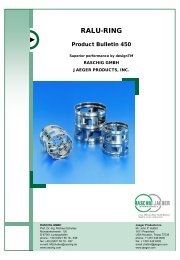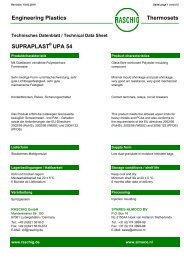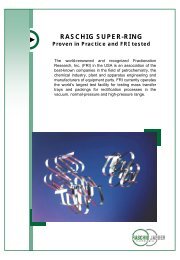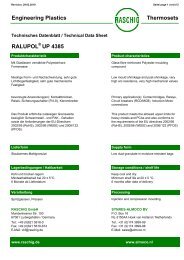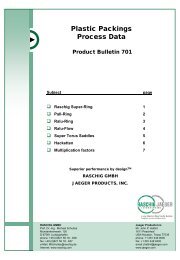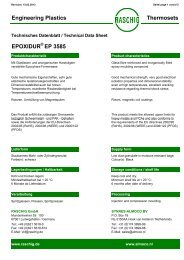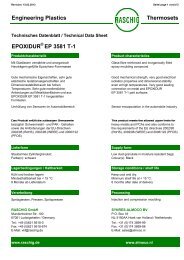Literature - RASCHIG SUPER-PAK
Literature - RASCHIG SUPER-PAK
Literature - RASCHIG SUPER-PAK
- No tags were found...
Create successful ePaper yourself
Turn your PDF publications into a flip-book with our unique Google optimized e-Paper software.
emaining void fraction. Some packing manufacturers provide perforated plate sheetsin order to give the phases the opportunity to exchange through the holes in thesheets.On account of the bridging formations however, the liquid often covers the smallholes in the sheet so that the flow phase exchange is restricted between twoadjacent channels. In the case of foaming systems, it was found that the fluiddynamics of perforated packing structures has an adverse affect, as the passage ofgas through the holes forms bubbles and as such, promotes the development offoam. In the case of packings with low specific surfaces (≤ 300 m 2 /m 3 ), the holeswere found to have no significant effect on the fluid dynamics of packing and itsbehaviour in relation to separation performance.Question 3: Is the vertical profile position in the transition area of the packing layersin high-performance packing the most dynamically efficient design in relation to thefluid flow?In the channel structures of standard packing, an increase in capacity results out ofnecessity on the vertical position of the flow channels in the transition areas of thepacking layers. The question however is whether the phase transition between thelayers can be facilitated by using an entirely different packing structure.SHOW FIGURE 2Fig. 2: The Raschig Super-Pak with its innovative lamellar structure (top) and view ofa packing layer in the flow direction of the gas phase (bottom)Fig. 2 (above) shows the structure that has resulted from the considerationsdescribed above and experiments into fluid dynamics. The structure of the RaschigSuper-Pak is formed through narrow, wave-like loops, which alternately pass out of
the packing sheet in an upward and downward motion. The loops run inclined to thehorizontal and the sheets are turned in relation to each other by 180°. Due to thenarrow alternating loops, the Raschig Super-Pak retains an extremely open structurewhich no longer exhibits flow channels. As such, localized bottlenecks relating to fluidflow and the phenomena of preflooding are ruled out. Fig. 2 (below) also shows aview of the new packing structure in the direction of the gas flow when entering a newpacking layer. When transgressing into the next packing layer, the extremely openstructure does not force the gas to change direction. The following chapters willshow, that this innovative surface geometry allows especially high capacity levels andexcellent results in terms of separation performance.Comparison of the Raschig Super-Pak with standard and high-performancestructured packingIn order to be able to evaluate the performance of the Raschig Super-Pak (RSP),tests were performed as part of the SRP at the University of Texas in Austin. Thedistillation mixture of cyclohexane / n-heptane was used as a test system at fourdifferent pressures. With this system, studies of standard performance and highperformancestructured packings have been carried out both at the SRP and at FRI(Fractionation Research Inc.) in Stillwater, Oklahoma.The newly developed Raschig Super-Pak 250 has an enhanced surface texture. Inorder to identify this surface, the packing will be referred to as Raschig Super-Pak250 wSE (with surface enhancement). In an earlier article /1/ the Raschig Super-Pak300 was introduced with a smooth surface. For comparison, the results of thispacking will also be described (this packing is referred to as the Raschig Super-Pak300 woSE (without surface enhancement).Description of the test columnThe SRP test column has an inside diameter of 429 mm and was filled with RaschigSuper-Pak up to a packing height of 3124 mm. Detailed observations concerning thesetup of the experiment and the experimental procedure can be found in publication/2/.The SRP standard distributor with 145 drip points per m 2 column cross sectional areawas used as the liquid distributor. Cyclohexane/n-heptane was selected as thedistillation test system at pressures of 4.14 bar, 1.65 bar., 0.33 bar and 0.165 bar.The tests were carried out at an infinite reflux ratio (total reflux). The Montz B1-250(standard packing) and Montz B1-250M (high-performance packing) were also testedat the SRP and analyzed under identical conditions.Likewise, the performance figures of the Raschig Super-Pak are also comparedbelow with the Sulzer packing M 250Y (standard packing) and M 252Y (highperformancepacking) tested at the FRI in each case. The FRI test column has adiameter of 1219 mm and is equipped with a packing height of 3670 mm. The FRIstandard pan type distributor (TDP type) was used as the liquid distributor for the M250Y Sulzer packing. The M 252Y Sulzer high-performance packing was tested withSulzer's VKG high-performance trough type distributor. Further experimental detailscan be found in publication /3/.
Evaluation of the separation performance and capacity of the Raschig Super-Pak at different column pressuresFig. 3 shows the separation performance of the measured Raschig Super-Pak 250 atthe four distillation pressures. The separation performance is shown in terms of theheight of a theoretical plate (HETP-value) in m, over the specific liquid load u L inm 3 /m 2 h.At a pressure of 4.15 bar, the packing structure of the Raschig Super-Pak could notbe flooded because the capacity of the evaporator and condenser was not sufficient.Fig. 3: Separation performance of the Raschig Super-Pak 250 wSE for rectification atdifferent column pressures shown over the liquid load in the case of total refluxFig. 3 shows that the Raschig Super-Pak achieves consistently good separationefficiency over a wide liquid loading range. The limit for the lowest liquid load wasdetermined by the lower limit capacity of the liquid distributor. The upper load rangeis limited by the flooding of the packing.In the following, the measurements at 4.14 bar and 0.33 bar are looked at moreclosely. This is because these results offer particularly characteristic findings. Theresults can be transferred to other pressures in the same way.Evaluation and comparison of the test results for the Raschig Super-Pak at p =4.14 barFig. 4 shows the separation performance results for the Raschig Super-Pak 250 wSE
and Raschig Super-Pak 300 woSE at p = 4.14 bar for the cyclohexane/n-heptane testdistillation system applied across the vapour capacity factor F V in Pa . The vapourcapacity factor is calculated from the vapour velocity u V in m/s related to the columncross section area multiplied by the square root of vapour density ρ V in kg/m 3 .Fig. 4: Separation performance of the Raschig Super-Pak 250 wSE and the RaschigSuper-Pak 300 woSE for rectification shown over the vapour capacity factor in thecase of total refluxAlthough the specific surface of the Raschig Super-Pak 250 wSE is 17% smaller thanthat of the Raschig Super-Pak 300 woSE, the surface enhancement has a verypositive effect on the separation performance. Due to the rough surface, the fluidcontent increases in the column and the liquid film is more turbulent. Both thesefactors combined have the effect that the separation performance of the RaschigSuper-Pak 250 wSE is about 15% better than that of the smooth Raschig Super-Pak300 woSE.Fig. 5 opposes the pressure drops of the Raschig Super-Pak 250 and 300 to those ofthe B1-250 and B1-250M Montz packing. The Montz packing was measured at theSRP with the same test column structure.It is noticeable that the course of the pressure drop for the Raschig Super-Pak 250wSE does not differ from that of Raschig Super-Pak 300 woSE. Obviously, with theincreased fluid content of the Raschig Super-Pak 250 wSE, the rough surface overcompensates the normally expected pressure drop reduction due to the lowerspecific surface area.Compared to the Montz packings, both Raschig Super-Pak surfaces achieved asubstantially smaller pressure drop and a much greater capacity limit. In comparison,the B1-250 Montz standard packing indicated the highest pressure drop. The B1-
250M Montz high-performance packing offers significantly lower pressure drop thanthe B1-250, but again, the Raschig Super-Pak 250 wSE is significantly below this.Fig. 5: The pressure drop of Raschig Super-Pak 250 wSE and the Raschig Super-Pak 300 woSE compared to the B1-250 and B1-250M Montz packing for rectificationshown over the vapour capacity factor in the case of total refluxThe large differences in pressure drop and capacity characterize the fundamentallydifferent fluid-dynamic properties of the Raschig Super-Pak. Through theperpendicular position of the lamellar packing structure, there is very little flowresistance for the gas. This also applies to the area between two packing layers, thusresulting in much greater capacities. The narrow lamellae further ensure that thepacking sheet is coated by liquid from both sides, something which together with thesurface corrugation leads to excellent mass transfer performance.Evaluation and comparison of test results for the Raschig Super-Pak at p =0.33 barFurther comparisons are offered from distillation experiments at 0.33 bar. First, Fig. 6(top) shows the comparison in separation performance of the Raschig Super-Pak 250wSE in the form of the HETP value against the separation performance of the B1-250and B1-250M Montz packing. With the B1-250M Montz high-performance packing,separation performance is deteriorated when compared with the B1-250 standardpacking. This is not seen with the Raschig Super-Pak. In fact, the HETP values ofthe Raschig Super-Pak 250 wSE are below those of the Montz 250 standardpacking. Besides this, the Raschig Super-Pak 250 wSE is characterized by a muchgreater capacity than the two Montz packing types.
In Fig. 6 (btm) the Raschig Super-Pak 250 wSE is compared to the M250Y Sulzerstandard packing and the M252Y Sulzer high-performance packing. This comparisonalso shows that the Raschig Super-Pak 250 wSE had the best separationperformance and the greatest capacity.Fig. 6: Separation performance of the Raschig Super-Pak 250 wSE compared to thestandard packing and high-performance packing of Montz and Sulzer for rectificationshown over the vapour capacity factor in the case of total reflux. Sulzer packing istested at FRI.Fig. 7 shows the pressure drop comparisons between the Raschig Super-Pak andthe Montz and/or Sulzer packing.Again, compared to the Montz standard packing and the Montz high-performancepacking, the Raschig Super-Pak's significantly smaller pressure drop and muchgreater capacity is evident. The same is true from the comparison made with the
Sulzer packing, where the course of the pressure drop of the M252Y Sulzer highperformancepacking was just as low as the Raschig Super-Pak. The Raschig Super-Pak only achieved lower pressure drop than the M252Y Sulzer high-performancepacking with high vapour capacity factors.Fig. 7: Pressure drop of the Raschig Super-Pak 250 wSE compared to the standardpacking and high-performance packing of Montz and Sulzer for rectification shownover the vapour capacity factor in the case of total reflux. Sulzer packing is tested atFRI.When making a comparison with the Sulzer packing, it should be noted that theSulzer packing was not been measured as part of the SRP but at FRI. FRI testsstructured packing, while the same material system, but with a diameter of 1219 mm.This column is significantly larger than the one used in the SRP. In an earlier study,Olujic /4/ was able to show that the pressure loss of structured packing decreaseswith increasing column diameter. For this reason, with larger column diameters, the
pressure drop of the Raschig Super-Pak could possibly turn out to be lower;however, this experiment has not yet been performed.Figure 8 shows the comparison of the pressure drops per theoretical plate for thedifferent packing structures. Particularly low pressure drops per theoretical stage areimportant for vacuum distillation. Again, the Raschig Super-Pak exhibits significantadvantages over the Montz and Sulzer packings.Fig. 8: Pressure drop per theoretical plate of the Raschig Super-Pak 250 wSEcompared to the standard packing and high-performance packing of Montz andSulzer for rectification shown over the vapour capacity factor in the case of totalreflux. Sulzer packing is tested at FRI.
Assessing the capacity of structured packing at the design pointWhen making a comparison of capacities at the design point of mass transfercolumns, one finds two fundamentally different approaches. Fig. 9 attempts to makethis clear. Fig. 9 shows the separation performance and pressure drop of Montzpacking compared to the Raschig Super-Pak.Fig. 9: Determination of the capacity limits of structured packings in a rectificationprocess1st approach: Standard packing such as the B1-250 Montz packing is often designedfor a maximum pressure drop of 3 mbar/m, see Fig. 9 (btm). High-performancepackings such as the B1-250M Montz packing is designed for greater permissiblepressure drops, e.g, 5 mbar/m. A 44% capacity increase results. If one applies thesame pressure drop criterion of 5 mbar/m for the Raschig Super-Pak 250 wSE, there
is a capacity increase of 66% compared with the standard packing and a capacityincrease of 15% compared to the Montz-type high-performance packing. The upperdiagram shows the corresponding separation performance. It is clear to see that forthis type of evaluation, the high-performance packing types move significantly closerto the flood limit, so that under certain circumstances, the column operation reactsmore sensitively to load fluctuations.2nd approach: A different kind of capacity comparison of is based on comparing thepercent capacities on flood-point comparison of a packing structure (vertical rise ofthe function curves in the case of separation performance and pressure drop). Similarvalues for comparing capacities is offered by applying the last effective separationpoint on the separation performance diagram, see Fig. 9 (top). With thesecomparative criteria one obtains an 18% increase in capacity amongst highperformancepacking compared to standard packing. In this comparison, the RaschigSuper-Pak achieved an 8% increase in capacity compared to Montz highperformancepacking and a 27% increase in capacity compared to the Montzstandard packing.The design of a distillation column takes place according to this observation: e.g.,with a vapour load which corresponds to 75-80% of the flood point. Table 1 providesa summary of the capacity gains to be expected with the Montz and Sulzer highperformancepacking compared to their standard products. As a basis forcomparison, the last effective separation point of the products is used in accordancewith Fig. 9 (top). The basis for comparison (100%) is represented by the capacity ofthe B1-250 Montz standard packing. The table also shows the capacity gains whenusing the Raschig Super-Pak.Impressively, it is clear that in comparison with their standard products, the capacitygains of high-performance packings can sometimes be doubled if the Raschig Super-Pak is used. The fact that these gains in capacity are also accompanied by aseparation performance gain of approximately 5-15% when compared to Montz orSulzer high-performance packing is particularly impressive.
SummaryOn the basis of the experiments presented it can be seen that the Raschig Super-Pak represents a fundamentally new design geometry for structured packing whichleads to significant advantages in separation performance, capacity and pressuredrops compared to standard packing and to other high-performance packing. It isastonishing that at the same time, the benefits show up which are due to the optimalfluid dynamics of the geometry. Apart from low levels of flow resistance inside thepacking, there is in an unobstructed transgression of gas between the packing layers.In addition, the narrow lamellae of the Raschig Super-Pak ensure that the liquid hasthe tendency to wet the structure simultaneously from both sides.NomenclaturedDiameter, mF V Vapour or gas capacity factor uV⋅ ρV, PaHHeight, mL Mole flow rate of the liquid, kmol/h -1n thpu LNumber of theoretical platesPressure, barLiquid velocity, related to the free column cross section, m 3 /m -2 h
u VVHETPVapour velocity, related to the free column cross section, m 3 /m 2 sMole flow rate of the gas, kmol/hHeight equivalent to the theoretical plate, mGreek SymbolsΔP Pressure drop, mbar/mρ Density, kg/m 3IndicesLSVLiquidColumnVapour or gasBibliography[1] M. Schultes, S. Chambers, IChemE 2007, 85 (A1) 118-129[2] Z. Olujic et al., Chem.Eng. & Processing, 2000, 39 335-342[3] T. J. Cai, G.X. Chen, C.W. Fitz, J.G. Kunesh, IChemE 2003, 81 (A) 85-93[4] Z. Olujic, IChemE 1999, 77 (A) 505-510Tab. 1: Comparison of the capacities of different packings for variouscolumn pressuresProductsupplierp = 4.140barp = 0.333barStandard packingB1-250MontzM250YSulzerHigh-performance packingB1-250MMontzM252YSulzerRSP 250Raschig100 % -- 110 % -- 122 %100 % 95 % 118 % 120 % 127 %



